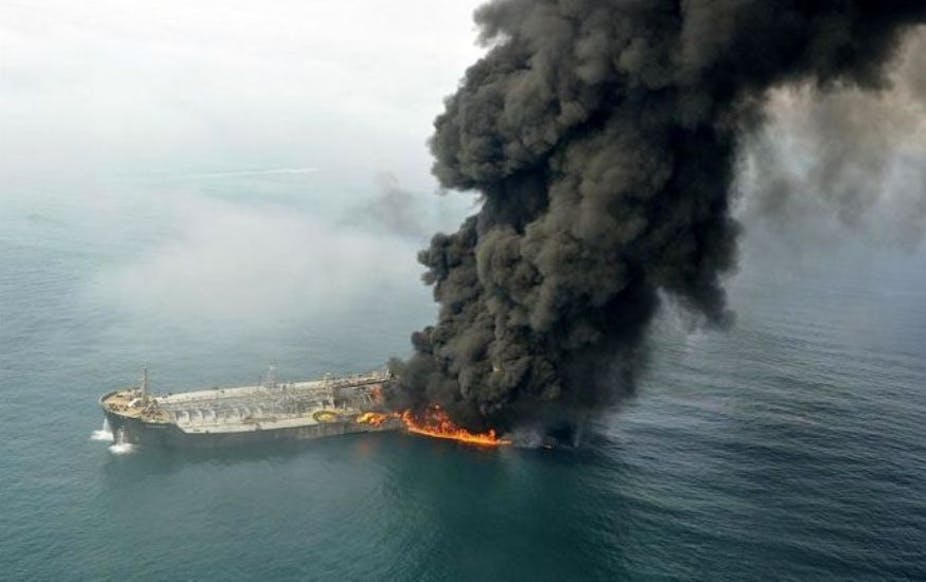The Sanchi tanker was carrying 136,000 tonnes of oil from Iran to South Korea when it collided with the Hong Kong-flagged cargo ship CF Crystal, 160 nautical miles off the coast of Shanghai, China. The collision on January 6, 2018 caused a serious fire, and the oil tanker eventually sank eight days later. All 30 Iranian and two Bangladeshi seafarers died in the accident. The other vessel, CF Crystal was damaged at a comparatively minor scale and all of its 21 Chinese crew were rescued.
Although this was the most significant oil tanker accident since the Prestige tanker spilled 77,000 tonnes of heavy oil into the Atlantic off the coast of Spain in November 2002, its environmental impact was, at least, less severe than other similarly large disasters. Its cargo was light crude oil and most of it entered the atmosphere following the fire so it had less impact on the ocean. The accident also happened in the open sea, far from places where people live so the impact on human activity is likely to be minimal.
But every time a disaster like this happens, it forces shipping companies and governments to look again at how tankers are designed and operated. For example, the loss of the Amoco Cadiz in 1978 led to the requirement for there to be two or more identical power units operating the rudder for tankers of 10,000 gross register tonnage and above. So the Sanchi accident will likely have an impact on future ships.
Once the causes leading to the accident are clearly identified, it will then be possible to work out where risks can be reduced and how this could be fed back into the design of new tankers and improve how ships run. The most important improvements are likely to be those that target the weakest link in the operation: the fallible human crew.

Other previous oil spills have had more of an effect on the physical design of ships and the technology they use. For example, the Prestige tanker disaster shocked the public and focused attention on tanker safety. As a result, the EU banned single hull tankers carrying heavy oil from entering its ports, bringing it in line with US restrictions introduced after the 1989 Exxon Valdez disaster. It is less likely for double hulled and double bottomed ships to have oil spills because the inner hull and bottom provide an extra layer of protection for leakage.
Yet while ship design may be improved through the introduction of risk-mitigating measures, around 80% of maritime accidents are actually caused (directly or indirectly) by human error. For example, the motor tanker Sea Empress, which grounded off the coast of Wales in 1996, released 2,500 tonnes of crude oil, with a further 69,000 tonne lost during salvage. The main cause was an error by the pilot, who failed to take appropriate and effective action to keep the vessel in the deepest part of the channel because they had insufficient training and experience of large tankers. The impact was that pilots subsequently had to be appropriately trained using simulators.
Human error
Given that the Sanchi collided with another ship, it’s highly likely human error played a similar role in this accident. Human error can be reduced through more resilient design with greater redundancy so that if one system stops working, another takes over. Traditionally this has meant things like using two engines instead of one. But new technology such as intelligent sensors can also make a difference by automatically detecting when problems occur, such as faults in a hull structure. Similarly, introducing more safety warning devices and improving crew training, supervision and communication could help prevent human errors and catch them earlier when they do occur.
The other technology that could reduce human error is automation. All ship operations including navigation, propulsion and things like loading and unloading can be automated – although eliminating human crew altogether would introduce other safety issues by making the ship entirely dependent on software. Much of the technology to make this possible already exists or is under development.
But in the near future, it is unlikely for many shipping companies will introduce such automation. Unmanned ships aren’t yet allowed to operate in international waters and there are many other obstacles yet to be overcome relating to things like insurance and regulations. The other issue is that the marine industry always tries to minimise possible costs, and so often accepts a certain amount of risk if it is cheaper to do so. Unless shipping companies have evidence automation will reduce their costs, they are unlikely to change their operational culture in a short period of time.

